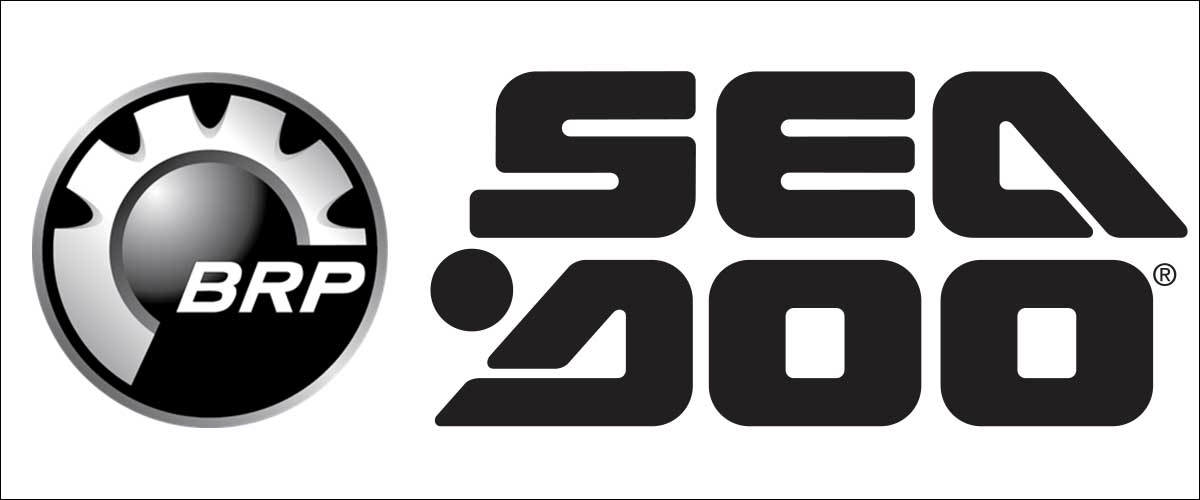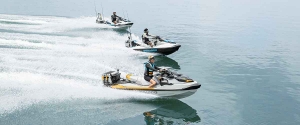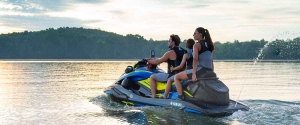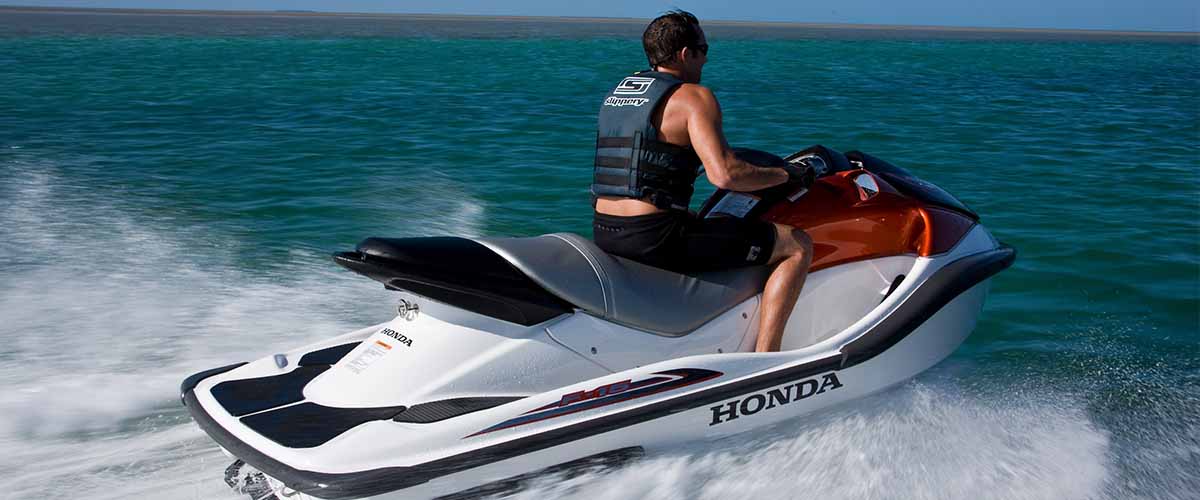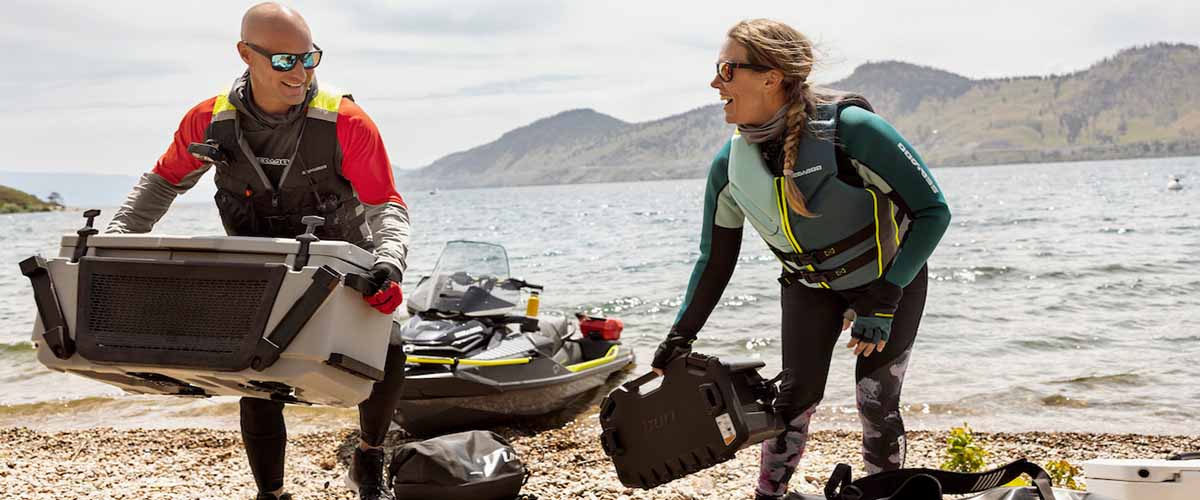Sea-Doo Models By Year [1968-2024]
Are you looking for a detailed model reference history of Sea-Doo PWCs? You’ve come to the right place!
We at JetDrift have compiled all Sea-Doo models by years from the ancient 1968 “Aqua Scooter” to the latest skis under one roof!
Disclaimer: This post is just for informational purposes, as it may contain errors or omissions!
1968 Sea-Doo Models
Contrary to popular belief, Kawasaki jet skis were not the first personal watercrafts in history.
Although these crafts brought popularity to this sport, the first mass-produced PWC was the 1968 Bombardier Sea-Doo 320 (a.k.a. the Sea-Doo 318 or “Jet-Powered Aqua-Scooter”).
This ski was built on a strange, flat-bottomed hull measuring 94 inches in length and 58 inches in width.
The power source of the Sea-Doo 320 was an air-cooled, single-cylinder, 2-stroke Rotax engine rated at 18 HP. Due to an inefficient and underpowered engine and pull-start, this model got a bad reputation.
Discover the 1968 Sea-Doo Lineup:
1969-1970 Sea-Doo Models
In 1969, the manufacturer released the more powerful Sea-Doo 370 (a.k.a. Sea-Doo 372) featuring a water-cooled, 372cc, single-cylinder Rotax engine. This power source proved to be more reliable and cranked out 24 HP.
The driveline also saw some changes as the awkward, snowmobile-like belt drive system was replaced with a clogged belt and pulleys.
Along with the more advanced 370, the 320 model remained part of the 1969-1970 lineup.
The biggest drawback of these skis was inadequate waterproofing, so corrosive saltwater caused severe damage to the engine and electrical system.
Because of poor sales figures and countless warranty problems, BRP decided to cease its entire Sea-Doo line after the 1970 season.
Key news and changes for 1969-1970:
- New model: Sea-Doo 370
- New 372cc Rotax engine rated at 24 HP
- Water-cooling system
- Revamped drivetrain with a clogged belt and pulleys
- Electric start
Discover the 1969-1970 Sea-Doo lineup:
1969-1970 Bombardier Sea-Doo 320
1969-1970 Bombardier Sea-Doo 370
1988 Sea-Doo Models
Encouraged by the success of Yamaha and Kawasaki, Sea-Doo PWCs made a noisy comeback in 1988.
The first modern Sea-Doo PWC was the 1988 SP.
It featured a unique, 20-degree, semi-V fiberglass hull measuring 96 inches in length, 41.5 inches in width, and 36.2 inches in height.
As far as the power source, the SP utilized the 2-cylinder, 2-stroke, Rotax 587 Yellow engine rated at 56 HP. Sea-Doo carried over this power mill for all 1989-1991 models.
Although the SP was rated for two riders, riding it with an adult passenger was virtually impossible.
Key news and changes for 1988:
- Sea-Doo re-entered the PWC market
- New model: Sea-Doo SP
- New, semi-V fiberglass hull
- Rotax 587 Yellow engine (56 HP)
Discover the 1988 Sea-Doo lineup:
1989 Sea-Doo Models
The 1989 Sea-Doo SP was a revamped version of its predecessor. Its top deck had been redesigned and utilized a practical removable seat while the hull and the mechanical parts remained unchanged.
This new seat configuration was a game-changer as it ensured easy access to the engine bay as well as the propulsion system.
The manufacturer used this platform on each SP model through late 1993.
Like the ’88 model, the engine of the 1989 Sea-Doo SP was the single-carb “Yellow” Rotax 587 twin.
Key news and changes for 1989:
- Redesigned top deck
- Removable seat
Discover the 1989 Sea-Doo lineup:
1990 Sea-Doo Models
The 1990 Sea-Doo fleet was expanded with a brand new touring PWC, the 3-seater Sea-Doo GT.
It was powered by a more advanced, dual-carb version of the Yellow Rotax 587. This engine was nestled in an all-new GT platform, measuring 119.3 inches in length, 47.6 inches in width, and 37.4 inches in height.
Surprisingly, this hull featured a smooth bottom, providing a “slippery” riding experience. It was great for tricks like power slides and spins, but it also slid out too easily in sharp turns.
Although the GT was marketed as a 3-seater ski, it offered minimal stability with two adult passengers.
The 1990 GT was also the first ski in Sea-Doo’s offerings, engineered with manual reverse. Later this feature found its way to most mid-level and high-end models.
Besides the GT, the SP remained part of the fleet, featuring the single-carb 578 Rotax twin.
Key news and changes for 1990:
- New model: the 3-seater Sea-Do GT
- Sea-Doo’s first manual reverse system debuted
- Dual-carb Yellow Rotax 587 engine
Discover the 1990 Sea-Doo lineup:
1991 Sea-Doo Models
For the 1991 season, Sea-Doo introduced a more advanced version of the SP, branded as the Sea-Doo XP.
These models were basically identical, except the XP utilized a dual-carb engine configuration and dual mirrors integrated into the front hood. This unique top deck configuration remained the trademark of XPs throughout their entire life.
The XP was positioned as the performance model, which would undergo many different generations throughout the following 13 years.
Besides the XP, Sea-Doo also marketed the GT and the SP in this model year. To the greatest delight of riders, the SP came equipped with a rear grab handle. Its predecessors lacked this feature, making it hard to reboard from deep water.
Each of these models shared the same Yellow Rotax 587 twin engine. However, the SP got a single-carb configuration of this engine, while GT and XP models got a higher performance, dual-carb version.
Key news and changes for 1991:
- New model: Sea-Doo XP
- Rear grab handle on the SP
Discover the 1991 Sea-Doo lineup:
1992 Sea-Doo Models
By 1992, the redesigned “White” Rotax 587 engine had replaced its retired Yellow predecessor. This new power source came with some improved features, including:
- Upgraded exhaust manifolds
- More advanced cooling system
- Revamped electrical system (improved MAG housing design and cooling)
- White paint job
This second-generation Rotax 587 engine was used throughout the entire ’92 Sea-Doo fleet.
The SP remained unchanged except for its new engine, while the XP was upgraded with a manual trim system.
As far as 3-seaters go, the GT was rebranded as the GTS, and its hull was also revamped. The new design featured strakes on its hull, providing improved handling and better stability in turns.
Key news and changes for 1992:
- GT was rebranded as GTS
- New “White” Rotax 587 engine
- Manual trim system
- Upgraded GTS hull with strakes
Discover the 1992 Sea-Doo Lineup:
1993 Sea-Doo Models
The 1993 Sea-Doo lineup brought many exciting upgrades, including several new models and engines. Let’s take a closer look at each!
One of the biggest news items in the PWC world for 1993 was Sea-Doo’s all-new Rotax 657 engine (650cc, 2-stroke twin).
The flagship XP 650 featured a dual-carb version of this engine rated at 70 HP and a more durable pump with bronze wanes. This model also got an entirely new hull and top deck along with the innovative VTS electric trim system.
In contrast, the SP still featured the outdated hull and top deck and the single-carb 587 Rotax engine.
Besides the base SP, Sea-Doo released the more advanced SPI featuring an upgraded pipe and a stainless-steel impeller.
Surprisingly, the 1992 Sea-Doo XP was still marketed that year under the brand name SPX. It shared its hull and features with SP models, utilizing a dual-carb 587 Rotax engine.
In the following years, Sea-Doo continued to offer the prior year’s XP models as SPX.
The lineup also included the base 3-seater GTS (55 HP) and its more advanced version, the GTX. This machine featured a fuel gauge, a speedometer, and a stronger engine with dual Mikuni carburetors rated at 60 HP.
The GTX was positioned as the high-end “Luxury” 3-seater Sea-Doo in the lineup. Over the decades, this model underwent many generations and is still available in the latest Sea-Doo fleet!
Key news and changes for 1993:
- New models: GTX, SPI, XP 650, SPX (= ’92 XP)
- Second-generation XP hull
- New Rotax 657 engine (70 HP)
- Upgraded jet pump with bronze vanes
- VTS electric trim system
Discover the 1993 Sea-Doo lineup:
1994 Sea-Doo Models
In 1994, the popular Sea-Doo XP returned with a revamped Rotax 657x engine.
It utilized a tuned exhaust system with a larger expansion chamber, improved timing, and dual Mikuni BN-38I carburetors. Thanks to these upgrades, the Rotax 657x cranked out 80 HP.
Aside from this change and the optional sponsons, the ’94 XP was identical to its predecessor.
Besides the XP, the flagship GTX was also powered by this engine option, and featured a gauge set, dual rearview mirrors, and a bronze vane pump. These additions allowed the GTX to legally tow a skier or a wakeboarder.
Just like in the previous year, the SPX was identical to the 1993 XP.
The rest of the lineup – including the GTS, SPI, and SP was carried over from 1993 without any noticeable changes. Each of them still housed the single-carb Rotax 587 engine.
Key news and changes for 1994:
- New models: –
- Redesigned Rotax 657x engine
- Sea-Doo XP 657x (80 HP)
Discover the 1994 Sea-Doo Models:
1995 Sea-Doo Models
In 1995, the manufacturer revealed two new Rotax power sources.
The Rotax 717 (a.k.a. Rotax 720) was a 718cc, 2-stroke twin rated at 85 HP. Its more powerful brother, the Rotax 787 (a.k.a. 800), was a 786cc, 2-stroke twin rated at 110 HP.
The latter featured the innovative RAVE variable exhaust valves, dual Mikuni BN-40I carburetors, and a water injected expansion chamber.
There’s no question that the most exciting Sea-Doos in the 1995 lineup were the performance models.
The Sea-Doo XP was marketed with two engine configurations, both featuring the more advanced VTS trim system and the all-new X4 hull.
This platform was a huge improvement over the outdated 2nd-generation XP hull. Thanks to its popularity, this body remained in the lineup until the Millennium and today it is still considered one of the best Sea-Doo hulls ever built.
The entry-level ’95 XP 720 was powered by the Rotax 717, while the limited-edition XP 800 had a special 787x RAVE engine.
Unlike the base 787 engine, the 787x was overbored by the factory to expand its displacement beyond the 786cc limit. This modification allowed the XP 800 Limited to race in the 1200cc class.
Besides the deservedly popular XP, Sea-Doo released the motorcycle-like HX to race against the tiny WaveBlasters. This race-intended ski featured a unique suspension seat mounted on a long narrow hull, which required a lot of skill and expertise to ride.
The SPX was also offered that year, which was a ’94 XP with a Rotax 657 engine.
While the SP, SPI, and GTS were basically the same as the previous year, the GTX saw some minor changes. This flagship 3-seater utilized more modern mirrors, the upgraded 657x engine, and an optional touring saddle.
The latter was more comfortable than the base “bench-like” seat, but it could only accommodate two riders.
Key news and changes for 1995:
- New model: HX
- XP marketed in two versions: XP 720, XP Ltd. 800
- X4 hull
- Rotax 717 engine (85 HP)
- Rotax 787 engine (110 HP)
- Racing Rotax 787x engine (110 HP)
- Minor changes on the GTX
- More advanced VTS system
- First Sea-Doo suspension seat
- RAVE exhaust valves
Discover the 1995 Sea-Doo Lineup:
1996 Sea-Doo Models
In 1996 Sea-Doo introduced its more upgraded ECU, incorporating the secure DESS (Digitally Encoded Security System) with the Sea-Doo-exclusive programmable key.
Thanks to this more advanced electrical system, Sea-Doo could manufacture certain models with an LCD information gauge.
This new screen and the DESS system were only available on the high-end models, including the GTX and the new GSX.
Unfortunately, these features added a lot of complexity to the machines.
When it comes to engines, the manufacturer dropped the 657 engine from the entire lineup. The only available engine options were the Rotax 787, 717, and 587 twins.
The Sea-Doo fleet was also expanded with the new GSX featuring the Rotax 787 engine. This 2-seater runabout had larger dimensions and offered more stability and comfort than the nimble performance skis (XP, HX).
This was a high-performance 2-seater ski that could finally carry an adult passenger. Later Sea-Doo carried this idea on to the RXT line.
Another new ski was the GTI, which was virtually a ’95 GTX powered by a larger 717 engine.
The flagship GTX was completely redesigned, and returned with an entirely new platform, featuring the Rotax 787 engine, larger bow storage, a comfortable 2-piece seat, and many new features.
In contrast, the GTS, SPI, SP, and HX remained unchanged other than cosmetics with all featuring the single-carb Rotax 587 engine.
The ’96 Sea-Doo XP 800 was almost identical to the ’95 XP Limited 800, except that it housed the base 787 engine.
The SPX was also part of the lineup, equivalent to the ’95 XP.
Key news and changes for 1996:
- New models: GTI, GSX
- Completely redesigned GTX
- New ECU
- DESS System with programmable key
- LCD information gauge
Discover the 1996 Sea-Doo lineup:
1997 Sea-Doo Models
By 1997, Sea-Doo had discontinued the Rotax 587 twin engine, and instead revealed the high-performance Rotax 947 RAVE.
This 951cc, 2-stroke twin featured many advanced systems, including the RAVE exhaust valves, dual Mikuni BN-46I carbs, and variable rate oil injection.
The Rotax 947 cranked out an amazing 130 HP thanks to these features. This was nestled in the hull in a canted position, ensuring a lower center of gravity.
This power source was exclusively available in the GSX Limited.
The base GSX, GTX, and the HX were carried over from 1996, but with some new design elements, while the SPI got the 720 engine option.
The SPX was still available as the reincarnation of the ’96 XP 800.
New Sea-Doo models in the 1997 lineup were the GSI and the GS. Both shared their platform and propulsion system with the GSX (dual-carb 787) but were marketed with the single-carb 717 engine.
The entry-level model in this family was the GS, which lacked a VTS trim system and only featured a fuel gauge, while the mid-range GSI was virtually a GSX with a smaller engine.
The high-end model in the GS line was the flagship GSX Limited released in late 1997, but it was considered a ’98 model. This ski featured the new White Rotax 947 RAVE engine.
As far as the GT family, the ’97 GTS was a rebranded ’96 GTI without the LCD info center. This model was positioned as the entry-level 3-seater Sea-Doo.
The GTI was promoted as the mid-level 3-seater, featuring the new hull, 717 engine, and analog gauges (no info center). In contrast, the GTX was equivalent to its ’96 successor.
The most exciting ski in the 1996 Sea-Doo lineup was arguably the brand new, 4th generation XP.
This machine was built on the all-new parabolic hull, which offered a “lean-in” riding style. The top deck of the XP was also completely redesigned and featured the suspension seat. This design was inherited from the HX and looked like a motorcycle seat.
The engine was also moved toward the bow, which resulted in entirely new riding characteristics. This 4th generation XP was powered by the proven 787 RAVE engine rated at 110 HP.
Another race-intended Sea-Doo, the HX, was in the lineup from the previous year.
These models (except the GTS and the SPX) utilized the new, more complex MPEM module.
Key news and changes for 1997:
- New models: GSI, GS
- Discontinued: SPI
- Rotax 587 twin was ceased
- New engine: Rotax 947 RAVE (130 HP)
- 4th generation Sea-Doo XP with the new parabolic hull
- New MPEM module (except on the SPX and GTS)
1997 Sea-Doo Models:
1998 Sea-Doo Models
In 1998, the first fuel-injected Sea-Doo engine made its debut. Labeled as Rotax 787 RFI RAVE, this new power source came with an innovative semi-direct fuel injection system and RAVE exhaust valves.
This RFI engine was Sea-Doo’s first step towards less polluting, more fuel-efficient skis. Like its carbed counterpart, the 787 RFI (a.k.a. 800 RFI) was also rated at 110 HP.
The most powerful 2-stroke Sea-Doo engine, the Rotax 947 RAVE, was revamped this year. It returned with a silver paint job and higher reliability.
The high-end models, including the GTX Limited, GSX Limited, and the XP Limited, were designed with this dual-carb 947 engine. However, the GTX was offered with the 787 RFI engine as well.
Except for the new power sources, these models remained unchanged from ’97.
The GTI, GTS, and the base GS were almost identical to their successors, except for some cosmetic changes.
The SPX was lightened for this year resulting in the fastest Sea-Doo with an X-4 hull.
To the greatest regret of many fans, the HX was discontinued for this year.
Key news and changes for 1998:
- New model: (GSX Limited), GTX Limited, XP Limited
- Discontinued: HX, GSX, GSI, SP, SPI
- RFI semi-direct fuel injection system
- New engine: Rotax 787 RFI (110 HP)
- Upgraded Rotax 947 RAVE
- 4th generation XP with the dual-carb 947 engine
Discover the 1998 Sea-Doo lineup:
1999 Sea-Doo Models
The 1999 Sea-Doo lineup didn’t have too many changes since the manufacturer heavily focused on the Millennium models.
Because of this, most ’99 Sea-Doos, including the XP Limited, GTX Limited, GSX Limited, GTX RFI, GS, GTS, GTI, returned without any major changes.
The fleet was expanded with the new, fuel-injected GSX RFI. It was a GSX Limited with a different paint job, and a semi-direct injected RFI 787 engine.
The SPX was still part of the lineup for the last time, but it was slightly heavier than the ’98 model.
Sea-Doo discontinued the SPX and the extremely popular X4 hull for the Millennium.
Key news and changes for 1999:
- New model: GSX RFI
Discover the 1999 Sea-Doo lineup:
2000 Sea-Doo Models
Sea-Doo released many new models and a new power source for the Millennium.
The advanced Rotax 947 DI engine featured an orbital fuel injection and cranked out 130 HP, the same power as its carbed sibling.
This power source was used in the GTX DI and the RX DI. The latter was an entirely new ski designed from scratch, which was also marketed with the carbed 947 engine.
The RX had a larger performance Sea-Doo hull with a 2-rider seat. This platform was later carried over to the 4-stroke RXP.
Both models were equipped with a complete gauge package and electric VTS trim.
Besides performance and luxury models, Sea-Doo revealed the large 4-seater LRV. This ski was powered by the dual-carb 947 engine and shared the same features as the GTX limited.
Other models, including the XP, GT (GTX, GTI), and the GS (GS, GSX) families, weren’t changed except for getting new color schemes.
That year, Sea-Doo used Millennium decals on many skis while discontinuing the “Limited” badge on 947 models.
Key news and changes for 2000:
- New models: GTX, RX, RX DI, GTX DI, LRV (4-seater)
- Discontinued: GTX Limited, GSX Limited
- New RX platform
- First “real” fuel injection on Sea-Doos
- Rotax 947 DI engine (130 HP)
Discover the 2000 Sea-Doo lineup:
2001 Sea-Doo Models
After the plethora of new models had been released for the Millennium, the entire fleet was carried over for 2001 with some cosmetic tweaks.
The only remarkable change for 2001 was that most skis were offered in two color options.
As far as new models, the limited-edition RXX also made its debut that year. This ski was a race-intended RX upgraded with many performance modifications from the factory.
It was claimed to be the fastest stock 2-stroke jet ski in history, but it had a bad reputation for high maintenance, low durability, and limited availability. In the end, Sea-Doo didn’t sell too many of them in the U.S.
Another “new” model was the GTS, which was a rebadged GTI with fewer bells and whistles.
The rest of the 2001 Sea-Doo fleet was basically the same as 2000.
Key news and changes for 2001:
- New models: RXX, GTS
- Discontinued: GS, GSX RFI
- Certain models were marketed with two color options
Discover the 2001 Sea-Doo Lineup:
2002 Sea-Doo Models
The first 4-stroke Sea-Doo engine was introduced for the 2002 model year.
This “4-TEC” power source was a naturally aspirated, 1494cc Rotax triple rated at 155 HP and featured a closed-loop cooling system, a brand new MPEM, and ECU.
In the following years, Sea-Doo moved towards 4-stroke models. As for the 2-strokes, the writing was on the wall.
Another new feature for 2002 was the OPAS (Off Power Assisted Steering) system, which had mixed reviews. It debuted on the GTX 4-TEC and GTI LE models.
They shared the all-new GTI platform, specifically designed for the new 4-stroke power source. Compared to the outdated GTI models, these modern skis offered better capacities and stability.
Proven 2-stroke models were also part of the lineup, including the GTI, GTX, GTX RFI, GTX DI, RX, RX DI, XP, and the LRV.
The latter was marketed with the fuel-injected 947 DI power source.
Key news and changes for 2002:
- New models: LRV DI, GTI LE, GTX 4-TEC
- Discontinued: GTS, LRV
- First 4-stroke Sea-Doo engine (Rotax 4-TEC: 155 HP)
- OPAS (Off Power Assisted Steering)
- New MPEM and ECU
- Closed-loop cooling system
Discover the 2002 Sea-Doo Lineup:
2003 Sea-Doo Models
The first supercharged Sea-Doo engine was released for the 2003 model year. This 1494cc, 4-stroke Rotax triple was rated at 185 HP.
You could find two supercharged Sea-Doos in the fleet, the GTX 4-TEC SC and GTX Limited SC.
Besides its supercharged siblings, the naturally aspirated, 155 HP GTX 4-TEC was also part of the fleet.
Other models like the RX DI, GTI and the GTI LE remained unchanged other than some cosmetic changes. The latter two still featured the Rotax 720 engine, while the new GTI LE RFI was released with the 787 RFI power source.
The XP series saw its last update, as the 1993 XP already had the 947 DI engine, just like the LRV. This large 4-seater never became popular, so Sea-Doo ceased it after that season.
This was also the last year for the sporty RX line.
Key news and changes for 2003:
- New models: GTI LE RFI, XP DI, GTX 4-TEC SC,
- Discontinued: XP, GTX, RX, RXX, GTX RFI
- First supercharged Sea-Doo engine: Rotax 4-TEC SC (185 HP)
Discover the 2003 Sea-Doo Lineup:
2004 Sea-Doo Models
In 2004, Sea-Doo clearly moved towards 4-stroke technology. We could find fewer 2-stroke Sea-Doos in the ’04 lineup, as half of it consisted of 4-stroke models.
As far as performance models, the proven RX was replaced with the all-new supercharged RXP. Its engine was based on the supercharged 1494cc, 4-TEC Rotax, which already featured a more advanced supercharger and an intercooler.
(However, the ceramic washers of this supercharger were prone to break, causing severe engine damage. Therefore, the supercharger of the RXP 215 had to be rebuilt with metal washers.)
Thanks to these mods, the upgraded SC engine produced an amazing 215 HP and offered a top speed of 70 mph. The body of the ski was also based on the RX DI, but it had been extensively redesigned.
This high-performance model remained the most popular member of the Sea-Doo fleet for many years.
Since Sea-Doo invested most of its efforts into the RXP, the rest of the lineup remained fundamentally unchanged from 2003. These models included the GTI, GTI LE, GTI LE RFI, GTX 4-TEC, GTX 4-TEC SC, and the XP DI. Surprisingly, most of them even returned with the same colors.
We got only two new GT models this year, the GTX Wake and the GTI RFI. Like its base GTI sibling, the GTI RFI came with a simple analog gauge and without mirrors, but it utilized the Rotax 787 RFI engine.
The GTX Wake was the first Sea-Doo specifically designed for wakeboarders and wakeskaters. It was virtually a naturally aspirated GTX 4-TEC, featuring unique colors, wakeboard racks, and a retractable tow pylon.
Key news and changes for 2004:
- New models: RXP 4-TEC SC (a.k.a. RXP 215), GTX RFI, GTX Wake
- Discontinued: LRV DI, GTX DI
- More powerful supercharged 4-TEC SC engine (215 HP)
- Upgraded supercharger with intercooler
Discover the 2004 Sea-Doo lineup:
2005 Sea-Doo Models
To the greatest regret of many fans, Sea-Doo discontinued its XP family.
Instead of this extremely popular 2-stroke performance ski, the manufacturer offered the RXP 215 and the new 3-seater RXT 215. The latter was actually a GTX powered by the supercharged and intercooled 215 HP 4-TEC Rotax engine.
The RXT was larger and less lively than the 2-seater RXP, but it could easily carry two passengers.
Besides this new model, the other proven GTX Sea-Doos were still part of the lineup. The base GTX, the GTX SC, and the GTX Wake were carried over without any remarkable changes.
In contrast, the engine of the GTX 4-TEC Limited was upgraded to the 215 HP engine option.
The GTI family, including the GTI, GTI LE, GTI LE RFI, were also basically the same as their predecessors.
In the 2005 Sea-Doo lineup, an exciting new model was the 3D, the first and only “stand-up Sea-Doo” in history.
To be more precise, this ski offered five different top deck configurations, allowing you to transform the 3D from a stand-up ski into a sit-down.
Key news and changes for 2005:
- New models: RXT 215, 3D, GTX Limited SC
- Discontinued: XP DI
- More models with the supercharged 215 HP engine
Discover the 2005 Sea-Doo lineup:
2006 Sea-Doo Models
By 2006, Sea-Doo had discontinued its outdated 2-stroke GTI line. The new GTI and GTI SE were already built on an entirely new composite platform and utilized a 4-stroke, 130 HP engine.
This power source was the 1494cc, 155 HP, 4-stroke Rotax triple, but its performance was restricted to 130 HP.
The GTI was marketed as the base model, while the more featured GTI SE came with some bells and whistles like dual mirrors and a reboarding step.
The rest of the fleet, including the GTX, GTX SC, GTX Limited, Wake, RXT, and RXP, had no changes except for decals and paint jobs. Sea-Doo eliminated the “4-TEC” acronym from their GTX names.
For this season, Sea-Doo ceased all 2-stroke skis except the “transformer” 3D. This moderately-popular Sea-Doo returned with a more powerful 947 DI engine.
The 4-stroke Sea-Doos got a more modern ECU connected to the information gauge.
Key news and changes for 2006:
- New models: 4-stroke GTI and GTI LE, 3D DI
- Discontinued: 2-stroke GTI models
- All-new GTI platform
- The 3D got the 947 DI engine
- Restricted 4-TEC engine (130 HP)
- New ECU connected to the information gauge
Discover the 2006 Sea-Doo lineup:
2007 Sea-Doo Models
The 2007 Sea-Doo models only saw minor changes. The popular performance models, the RXT and RXP, got a new top deck with widened handlebars.
When it comes to new models, the only new addition was the non-supercharged RXP. This machine shared its body and features with the RXP 215 but utilized a naturally aspirated 155 HP engine option.
This model received mixed reviews and received a lot of criticism from PWC enthusiasts. As a result, the RXP 155 remained in production for only two short years.
The GTI and GTX series, including the GTI, GTI SE, GTX, and GTX Wake, were carried over from ’06 without significant changes, but the GTX SC was discontinued.
The 3D was in the lineup for the last year, as the last 2-stroke Sea-Doo in history.
In the electrical system of 4-stroke models, the functions of the MPEM were moved to the ECU. This means that these models didn’t utilize MPEM, only a simple fuse panel, and an ECU.
Key news and changes for 2007:
- New models: RXP 155
- Discontinued: GTX SC, 3D DI (the last 2-stroke Sea-Doo)
- New RXP and RXT top deck
- MPEM integrated into the ECU
Discover the 2007 Sea-Doo lineup:
2008 Sea-Doo Models
For 2008 Sea-Doo phased out its last 2-stroke ski, the 3D but released many new model variations. From this season on, Sea-Doos have been solely manufactured with 4-stroke engines.
The most exciting Sea-Doos in the 2008 lineup were arguably the new RXP-X and RXT-X.
Often referred to as “the X models,” these performance Sea-Doos came with revamped 1503 SC Rotax engines rated at 255 HP. Also, they utilized a unique seat and traction mats, adjustable X-racing handlebars, an electric trim system, and custom decals.
These Sea-Doos could do the 0-50 mph run in about 2.9 seconds thanks to their high-performance engine and features.
Besides these big boys, the RXP 155, RXP 215, and the RXT 215 were still part of the lineup. These skis saw only minor changes in this season.
Keeping rental companies in mind, Sea-Doo released the GTI SE 130. This ski shared its platform and features with the GTI SE 155, but its engine was restricted to 130 HP. Both of them were already built on the new composite platform.
The GTX family was also expanded with the GTX 215, which was virtually a GTX 155 with a supercharged engine. The base GTX 155 and the GTX Limited also remained part of the lineup.
Although the word “GTX” was dropped from Wake model names, these models still belonged to the GTX family.
Besides the naturally aspirated Wake 155, Sea-Doo released the supercharged Wake Pro 215. Both models were equipped with electric trim and a ballast system. This removable ballast could be mounted on the rear platform and accommodate 200 pounds of water.
Under the hood of supercharged Sea-Doos, you could find the redesigned, more durable supercharger. Unlike its unreliable predecessor with ceramic washers, this revamped unit came with metal washers from the factory.
However, these superchargers still required periodic rebuilds and maintenance as per their service manual.
Key news and changes for 2008:
- New models: RXT-X 255, RXP-X 255, GTX 215, GTI SE 130, Wake Pro 215
- Discontinued: No 2-stroke models in the fleet
- Revamped 1503 SC Rotax engine (255 HP)
- Redesigned supercharged with metal washers
Discover the 2008 Sea-Doo lineup:
2009 Sea-Doo Models
In 2009, the Sea-Doo-exclusive Intelligent Suspension seat (iS) made its debut. This innovative system was exclusively available on high-end models like the RXT iS, and the GTX Limited iS.
Besides this unique seat, these machines incorporated many advanced technologies, including the Intelligent Throttle Control (iTC), the high-performance VTS, and the Intelligent Brake and Reverse (iBR) system.
The electrical system was upgraded with a new ECU to manage these systems. This new computer and other high-end features added a lot of complexity to the machines and pushed manufacturing costs higher.
Other changes in 2009 were that the Wake models lacked standard ballast tanks, and the hull of the 155 model was made of composite.
The rest of the lineup didn’t see too many changes. The performance series still included the RXP 215, RXP-X 255, RXT 215, and RXT-255 but skipped the non-supercharged RXP 155.
These models only got some cosmetic changes, as did the GTI and GTI SE.
Key news and changes for 2009:
- New models: RXT iS, GTX Limited iS
- Discontinued: RXP 155
- iS – Intelligent Suspension
- iTC – Intelligent Throttle Control (throttle-by-wire)
- iBR – Intelligent Brake and Reverse System
- High-performance VTS
- New ECU
- Ballast tanks for Wake models
Discover the 2009 Sea-Doo lineup:
2010 Sea-Doo Models
After the plethora of new features in previous years, the 2010 Sea-Doo lineup didn’t offer much novelty.
The power of the flagship GXT and RXT models was rounded up to 260 HP. But this extra 5 HP was more of a marketing gimmick than a noticeable power increase.
This series, just like the Wake 215, came with the innovative iControl system that incorporated iBR, iTC, and VTS systems.
The Sea-Doos with the “iS” badge also housed the Intelligent Suspension seat.
Unfortunately, these advanced features didn’t come cheap, so the prices of these machines skyrocketed.
Let’s face it; these modern Sea-Doos were basically smaller boats rather than “personal” watercraft. Due to their complexity, they had to be taken to the dealership in case of a malfunction and even for regular maintenance.
Other models like the RXP-X and the GTI line were not changed much from 2009.
Key news and changes for 2010:
- New models: GTX iS 215
- Revamped Supercharged engine with 255 HP
- The 255 HP Sea-Doo models were upgraded to 260 HP
Discover the 2010 Sea-Doo Lineup:
2010 Sea-Doo GTX Limited iS 260
2010 Sea-Doo GTX iS 215
2011 Sea-Doo Models
The Sea-Doo GTI series was completely redesigned for the 2011 model year.
This family already had four members, including the GTI 130, GTI SE 130, GTI SE 155, and the most advanced GTI Limited 155. Sea-Doo also brought back the GTS, which was basically a base GTI without iBR.
The majority of the lineup had already incorporated the iControl system, including the VTS, iBR, and iTC features. The only exceptions were the GTS and RXP-X 255.
The Wake 155 also saw some changes from 2010.
Also, Sea-Doo released a simpler, manually Adjustable Suspension system. Compared to the overcomplicated Intelligent Suspension (iS) system, the Adjustable Suspension (aS) featured a much simpler design.
It came with a FOX Podium Nitrogen Shock mounted in the glovebox. It was much cheaper, more durable, and more reliable than its “Intelligent” counterpart.
This suspension configuration was exclusively available on the 2011-2016 RXT-X aS.
Key news and changes for 2011:
- New models: RXT-X aS 260, GTS 130, GTX 215, GTI Limited 155
- Discontinued: RXP 215, RXT 215
- aS – Adjustable Suspension system with FOX shock
Discover the 2011 Sea-Doo lineup:
2011 Sea-Doo GTX Limited iS 260
2012 Sea-Doo Models
In 2012, Sea-Doo introduced the all-new T3 hull and the Ergolock system on the revamped RXP-X 260.
The unique T3 hull was designed for aggressive cornering and was exclusively reserved for the RXP-X.
As far as the Ergolock system goes, it incorporated an hourglass-shaped Ergolock seat, canted footwells, and adjustable handlebars. These components were intended to “lock” the rider into the machine.
Besides the Ergolock, the new RXP-X had many advanced features, including spray deflectors, adjustable sponsons, and an upgraded VTS trim.
The RXP-X also received the slightly more powerful 260 HP engine configuration.
Sea-Doo released a new performance model for 2012. The GTR 215 was built on the GTI platform but utilized the supercharged 215 HP engine.
It was smaller and lighter than the high-end RXP and RXT series and came with fewer features. Thanks to its simplicity, the GTR was more affordable than its bigger brothers, which were exclusively available with the 260 HP engine.
The GTX family was also expanded with a new GTX S 155. This machine was identical to the GTX 155, but was equipped with a manually-adjustable suspension system.
Unlike the iS and aS systems, this suspension was much simpler and could be adjusted with a regular wrench.
Key news and changes for 2012:
- New models: GTR 215, GTX S 155
- All-new RXP-X 260 with T3 hull
- Ergolock system
- Upgraded VTS
- S – manually adjustable suspension
Discover the 2012 Sea-Doo lineup:
2012 Sea-Doo GTX Limited iS 260
2013 Sea-Doo Models
There were minimal changes to the Sea-Doo lineup for the 2013 season. Most of the skis remained fundamentally unchanged while the RXT iS 260 was discontinued.
This wasn’t a coincidence because the manufacturer put its resources into developing the all-new Spark family.
Key news and changes for 2013:
- New models: –
- Discontinued: RXT iS 260
Discover the 2013 Sea-Doo lineup:
2013 Sea-Doo GTX Limited iS 260
2014 Sea-Doo Models
There’s no question that the biggest news in the PWC world for 2014 was the introduction of the revolutionary Sea-Doo Spark. It was built on a unique Polytec hull and utilized the Rotax 900 ACE engine.
This entry-level “budget” ski carried the legacy of its 2-stroke predecessors. It was small, lightweight, and much more affordable than any other “couch” PWC in the marketplace.
Despite its small engine, the Spark offered a thrilling riding experience. Its nimble body was fun to ride and was also easy to move around on the trailer.
So, it was no surprise that more Sparks were sold than any other model for many years.
The rest of the lineup had only minor changes. The GTX 215 got a more advanced VTS system with preset trim positions and a “Limited” badge. Aside from these differences and its heftier price tag, this ski was identical to the 2013 GTX 215.
Sea-Doo started to use its composite hull on many models, including the GTR 215, GTS 130, and the GTI family.
The drawback of this new hull material was the noticeable (ca. 35 lbs.) weight increase, which translated to slower acceleration and top end.
Key news and changes for 2014:
- New models: GTS Rental, Spark series (2UP and 3 UP)
- Discontinued: RXT iS 260
- New Polytec hull (Spark)
- New Rotax 900 ACE engine 60/90 HP (Spark)
Discover the 2014 Sea-Doo lineup:
2014 Sea-Doo GTX Limited iS 260
2015 Sea-Doo Models
The 2015 Sea-Doo lineup didn’t have any fundamental changes except for new colors.
The manufacturer offered the Spark models with an optional trim system, while the GTS Renal was discontinued.
To make the system more reliable, Sea-Doo redesigned its DESS key, which already utilized the Radio Frequency (RF) technology.
Prices also went up by $100-$200 depending on the model, while the price of the base Spark 2UP remained at the previous year’s level.
In 2015, Sea-Doo exported a part of its production to Mexico.
Key news and changes for 2015:
- New models: –
- Discontinued: GTS Rental
- New DESS Key with Radio Frequency (RF) technology
Discover the 2015 Sea-Doo Lineup:
2015 Sea-Doo GTX Limited iS 260
2016 Sea-Doo Models
To the delight of performance-minded riders, Sea-Doo increased the performance of its high-end models.
The new supercharged 1630 Rotax ACE replaced the proven but aged 1503 engine. This unit cranked out 300 HP thanks to its larger displacement and more advanced features.
The 300 HP engine option was only available for the GTX Limited, RXP-X, and RXT-X models, which also featured the innovative Ergolock seat.
What’s more, the performance RXP-X and RXT-X models came with the complete Ergolock system.
The Sea-Doo RXT-X aS 260 with the adjustable suspension was in the lineup for the previous year.
Another new feature on Sea-Doos was the palm rest handle grips, which offered more comfort over the regular grip design.
GTX models, including the RXT and Wake series, returned with a larger, 42.8-gallon storage capacity.
iBR Sea-Doo models also enjoyed the second-generation iBR system that offered a shorter braking distance.
The Radio Frequency (RF) DESS key was standard on each Sea-Doo model that year.
Key news and changes for 2016:
- New models: RXP-X 300, RXT-X 300, GTX Limited 300
- Discontinued: RXP-X 260, RXT-X 260, GTX Limited 260
- New supercharged 1630 Rotax ACE engine (300 HP)
- Larger storage capacity on the GTX/RXT/Wake series
- 2nd generation iBR
- Palm rest handle grips
Discover the 2016 Sea-Doo Lineup:
2016 Sea-Doo GTX Limited iS 260
2017 Sea-Doo Models
In 2017 Sea-Doo introduced some new models while discontinuing a few outdated ones. The rest of the lineup also saw some important changes.
First, each 2017 Sea-Doo utilized the advanced “bolted” hull design that made the top deck completely removable. It allowed full access to the internals while a gasket between the hull and the deck ensured proper sealing.
As far as power sources go, the supercharged 215 HP engine was replaced by a more advanced, 230 HP unit. Other engines options, including the 130, 155, and 260 HP power mills, were also slightly upgraded for better fuel efficiency and performance.
New models in the lineup were the revamped Wake Pro 230 and the brand new GTR-X 230. The latter was virtually an RXP-X with a different top deck and smaller engine option.
Other new skis in the 2017 lineup were the Spark TRIXX 2UP and 3UP. Both models featured the “extended range VTS” that allowed you to rise or bury it into the water. As its name suggests, the TRIXX was capable of various sit-down PWC tricks like spins, power slides, and “wheelies.”
In contrast, Sea-Doo dropped the RXT-X aS 260 and its entire adjustable suspension system.
The lasts suspension models, called the GTX S 155, and GTX Limited S 260, were available with a much simpler manually adjustable suspension.
The GTI and GTS inherited the Rotax 900 ACE engine and the Polytec hull material from the Spark series.
This upgrade resulted in a significant weight increase, but a 50 HP drop in performance.
Key news and changes for 2017:
- New models: GTR-X 230, Wake Pro 230, GTX Limited S 260, TRIXX 2UP and 3UP
- Discontinued: RXT-X aS 260
- New 230 HP supercharged engine
- Bolted deck design
- Polytec hull on the GTI/GTS series
- Extended range VTS (TRIXX)
Discover the 2017 Sea-Doo lineup:
2017 Sea-Doo GTX Limited S 260
2018 Sea-Doo Models
In 2018, Sea-Doo introduced its all-new ST3 hull, manufactured with the BRP-exclusive CM-Tec (Closed Molded Technology). This special hull was protected with a multi-layer thermofilm coating, which claimed to be more durable than the industry-standard gel coat.
The ST3 hull featured a deep-V design equipped with sponsons and fixed trim tabs. It had a good reputation for its outstanding stability and predictability.
The top deck of this platform utilized an easy-access storage compartment that proved to be much more comfortable to use than regular bow storage.
Many 2018 Sea-Doos were built on the ST3 platform, including the GTX, Wake, and the RXT families. These skis came with many innovative features, including the LinQ accessories, USB charger, launch control, and optional waterproof Bluetooth audio system.
The latter was a complete 100-watt integrated audio system that could be connected to a smartphone via Bluetooth.
The only drawback of this system was that the speakers occupied some space in the footwells.
The manufacturer dropped the supercharged 260 HP engine while the 130/155/230 engines inherited many upgrades from the 1630 ACE 300 HP engine.
In contrast, the entry-level 900 ACE and 900 ACE HO were carried over without any changes.
Key news and changes for 2018:
- New models: –
- Discontinued: GTX Limited S 260, GTX S 155, RXT 260
- Sea-Doo suspension models were discontinued
- New ST3 hull and top deck
- CM-Tec (Closed Molded Technology)
- Launch control
- Integrated Bluetooth audio system
- Easy-access storage compartment
- USB charge
- LinQ attachment system and accessories
Discover the 2018 Sea-Doo lineup:
2019 Sea-Doo Models
It’s safe to say that the biggest news in the 2019 PWC market was the all-new Sea-Doo Fish Pro.
Jet ski fishing started its career in New Zealand and Africa, but it quickly found its way into the U.S. So, Sea-Doo grabbed the opportunity and created an entirely new PWC category dedicated to fishing.
The 2019 Sea-Doo Fish Pro was basically a modified GTX built on the extremely stable ST3 hull.
In addition to the features of the base GTX, the Fish Pro came with a rear platform extension, an 18.5-gallon fuel tank, LinQ cooler with cutting board, rod holders, and a 6″ Garmin GPS/Fishfinder as standard.
The integrated Bluetooth sound system was also offered on the Fish Pro as an option.
Another new model in the 2019 Sea-Doo Lineup was the GTI 130 PRO marketed for rental companies. Its 130 HP engine power could be restricted to 99 HP for better durability and reliability.
Sea-Doo marketed the GTI 130 PRO with and without the brake and reverse (iBR) system.
Certain models, including the RXT, RXP, GTX, and the Fish Pro, came with a new 7.6″ multi-function gauge and new handlebar switches. Sea-Doo inherited this customizable screen from their Can-Am brothers.
This advanced gauge displayed a lot of useful information about the rides and the less pleasant fault codes.
The jet pump sealing was upgraded on many models, while the entry-level 900 ACE engine returned with more advanced fuel injectors.
Sea-Doo also introduced a set of new LinQ accessories, including fuel cans, coolers, and cargo bags/boxes.
Key news and changes for 2019:
- New models: Sea-Doo Fish Pro, GTI 130 PRO (Rental model)
- 7.6″ multi-function gauge
- Revamped injectors in the 900 ACE engine
- Upgraded pump sealing
- New LinQ accessories
Discover the 2019 Sea-Doo lineup:
2019 Sea-Doo GTI 130 PRO (Rental)
2020 Sea-Doo Models
In 2020, Sea-Doo revealed the all-new GTI platform housing a more powerful, 170 HP engine. This new platform was reserved for the GTI family and the Wake 170.
Compared to its predecessor, this design was not only wider, but it also lowered the center of gravity. This new configuration provided more stability and comfort.
It was made of the improved Polytech 2.0 material, which was claimed to be lighter and more durable than regular fiberglass.
Surprisingly, the new GTI models inherited many advanced features from their higher-level brothers. They were equipped with the comfortable Ergolock seat, LinQ connectors, and larger storage, which incorporated a waterproof phone storage case in the glovebox.
The all-new 4.5″ digital display was standard on certain models like the GTR, GTI SE, and the Wake series. It incorporated many advanced functions, including slow mode and speed regulator.
As their name suggests, the 2020 GTI/GTX/Wake 170 Sea-Doos were already equipped with a more powerful, 170 HP engine. This power source was a revamped version of the 155 HP 1503 Rotax ACE engine.
The largest, 18.5-gallon Sea-Doo fuel tank also found its way to all GTX-based models, including the entire GTX family, the RXT-X, Fish Pro, and the Wake Pro.
Key news and changes for 2020:
- All-new GTI platform
- New features on the GTI series
- 1503 ACE 155 HP engine was upgraded for 170 HP
- New 4.5″ digital display with slow mode and speed regulator
- 18.5-gallon fuel tank in all GTX-based models
- Polytech 2.0 hull material
Discover the 2020 Sea-Doo lineup:
2021 Sea-Doo Models
In 2021, Sea-Doo released its innovative iDF (Intelligent Debris Free) technology. It was virtually a reverse gear in the driveline intended to reverse the direction of the impeller’s rotation.
The main idea behind the iDF was to clear the pump and the intake area with the press of a button. The early iDF Sea-Doo models suffered from various malfunctions, but these bugs were eventually worked out.
As far as model changes go, the GTX 230 Limited was replaced with the more powerful GTX 300. The top-of-the-line GTX Limited 300 also returned with a 7.8-inch-wide full color “panoramic” display.
The high-performance RXP-X 300 was completely redesigned. Its all-new T3-R platform housed a lot of new features, including the iDF system and the all-new transformable Ergolock seat.
Besides these innovations, Sea-Doo released a set of new LinQ accessories.
You can read more about the 2021 Sea-Doo Lineup here.
Key news and changes for 2021:
- New model: GTX 300
- Discontinued: GTX 230 Limited
- Completely revamped RXP-X 300 with the new T3-R platform
- iDF (intelligent Debris Free) system debuted
- 7.8-inch-wide full-color LCD display (available on the GTX Limited 300)
- Transformable Ergolock seat
- Several new fishing and LinQ accessories
Discover the 2021 Sea-Doo lineup:
2022 Sea-Doo Models
The majority of the Sea-Doo PWC fleet remained unchanged for this year, but we got two new Fish models.
So, the Sea-Doo Fish family now consisted of three skis, the Trophy, the Sport, and the Scout.
The latter was marketed as the entry-level Sea-Doo Fish model. It was built on a GTI hull and had a less powerful 130 HP engine option.
The mid-range model in this breed was the Sport, and the high-end Sea-Doo Fish Pro was labeled as the “Trophy.”
Both of these were built on the ST3 hull borrowed from the GTX line. They also come with many advanced systems and accessories, including iDF, iBR, iTC with trolling mode, Fishfinder/GPS, cooler, and rod holders.
Beyond these features, the high-end Trophy was marketed with a quick-connect livewell, dual batteries, an anchoring system, and a unique modular swivel fishing seat. The panoramic LCD screen was also available as an option.
Besides the new Fish Pro models, another big news for 2022 was arguably Sea-Doo’s all-new pontoon boats.
Called the Sea-Doo Swift family, this new fleet made its debut with three models, the base Switch, the Sport, and the Cruise. Each model was available with different hull and engine configurations.
You can read more about the 2022 Sea-Doo Lineup here!
Key news and changes for 2022:
- New models: Fish Pro Scout, Sport, Trophy, and Switch pontoon boats
- New fishing accessories
- The 7.8-inch panoramic display was available on more models
- iDF was available on most models
Discover the 2022 Sea-Doo lineup:
2022 Sea-Doo Switch (Pontoon boat)
2022 Sea-Doo Switch Sport (Pontoon boat)
2022 Sea-Doo Switch Cruise (Pontoon boat)
2023 Sea-Doo Models
In 2023, BRP revealed the innovative Sea-Doo Explorer Pro 170, which was literally a modified Fish Pro Sport 170.
But while the latter was geared for PWC fishing, the Explorer Pro was clearly designed for adventures and commercial use.
It was equipped with a wide range of innovative features like heavy-duty front bumpers, multi-LinQ plates, a front LinQ support, windshield, heated grips, and more.
Another new model that year was the flagship RXP-X Apex 300. This ski was literally a standard RXP-X 300 completed with a hydraulic steering dampener and Tech Package.
The APEX also enjoyed a custom color scheme enhanced with some carbon fiber elements.
The revolutionary iDF also became available on more Sea-Doos like the recreation GTI series, except for the smallest GTI 90, which was discontinued.
Aside from the new graphics, the rest of the lineup was carried over unchanged for that year.
You can discover the 2023 Sea-Doo models here.
2024 Sea-Doo Models
In 2024, high-end performance models returned with an upgraded 325hp engine
This means that the RXP-X 300 and the RXT-X 300 were phased out by the RXP-X 325 and RXT-X 325, respectively.
Another exciting new model in the fleet was the GTR-X 300, which was a revived successor of the popular GTR-X 230.
This mid-range supercharged Sea-Doo was built on the small GTI platform, so it offered a remarkable power-to-weight ratio for a reasonable price.
The Explorer Pro series was also expanded by the supercharged Explorer Pro 230.
For its 10th anniversary, the Spark family was slightly redesigned but returned with the same 900 ACE 60/90hp engine options.
You can find out more about the 2024 Sea-Doo models and their features in this review.
DISCOVER 2024 PWC MODELS Kawasaki, Sea-Doo, Yamaha, Krash…
